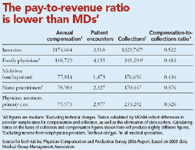Article
NPs and PAs: A seller's market
Author(s):
These "midlevel" providers are in demand, so your salary and working conditions had better be competitive.
If you're in the market for a midlevel provider, get ready to offer more than you might expect. In 2005, nurse practitioners in group practices earned a median of $70,503; physician assistants earned $75,573; and midwives, $77,814, according to the Medical Group Management Association.
But these clinicians easily pay for themselves-and then some. NPs, PAs, and midwives bring in more revenue in proportion to their compensation than internists and family physicians. Even when you factor in their overhead, you still get a bigger return on your investment.
Not surprisingly, these so-called "midlevel providers" are a hot item these days, particularly in primary care, where a shortage of physicians is prompting practices to plug in these clinicians, says Kurt Mosley, vice president of marketing at the recruiting firm Merritt, Hawkins & Associates in Irving, TX. "As demand goes up for internists and FPs, so does demand for midlevels," he says.

One of those signs is the emergence of in-store clinics in retail establishments like Walgreens, Wal-Mart, and Rite Aid that are staffed with NPs and PAs. "These new opportunities for midlevels make the market for them that much more competitive," says Ken Hertz, an MGMA consultant based in Alexandria, LA.
It takes more than just a generous salary, however, to attract-and keep-a good midlevel provider. Here's what you need to know about making a job offer they can't refuse. (In an upcoming issue, we'll tell you about recruiting-and retaining-an NP or PA for your practice.)
Spread the perks and sweeteners around
NPs and PAs are trained to diagnose illnesses and prescribe medication. Experts say they can handle roughly 80 percent of the medical problems-the relatively uncomplicated cases-that walk through the door of a doctor's office.

In addition, your NP or PA will expect the same kind of benefits you have. These include health insurance, malpractice insurance, a retirement plan, allowances for journals and continuing education, and paid time off to take the coursework. As would be expected based on salary differences, the level of those benefits will be less generous than yours. In 2005, MGMA numbers put the median for retirement benefits between $4,500 and $4,800 for NPs, PAs, and midwives, compared to $14,225 for internists and $12,529 for FPs who don't deliver babies.





